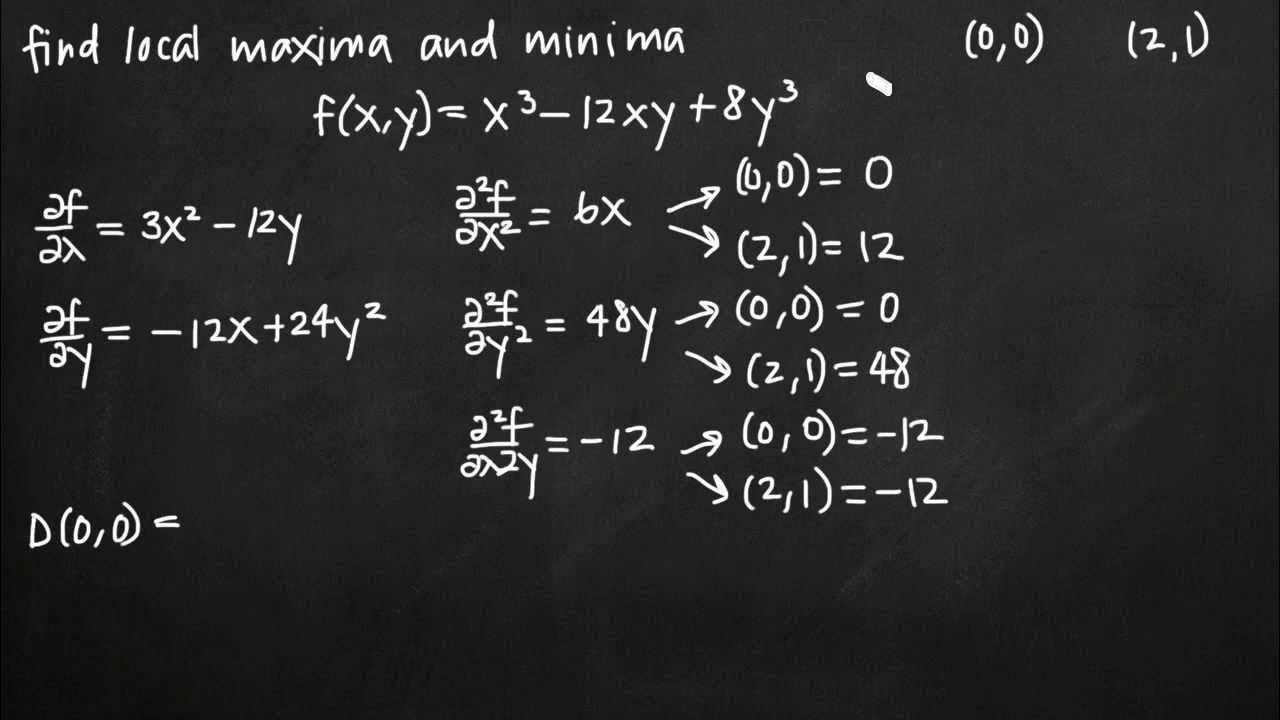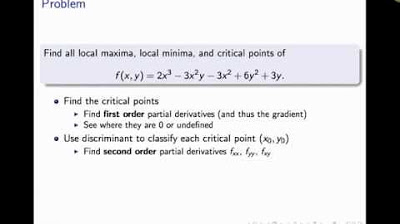Use the Second Derivative Test to Find Any Extrema and Saddle Points: f(x,y) = -4x^2 + 8y^2 - 3
TLDRThis video tutorial walks through the process of using the second derivative test to identify local extrema or saddle points of a function. The presenter begins by explaining how to find the first order partial derivatives with respect to x and y, setting them equal to zero to locate critical points. The critical point found in this example is (0,0). The second step involves calculating the discriminant, denoted as 'big D', which is a combination of second order partial derivatives. The sign of 'big D' and the second derivative with respect to x (fxx) determine whether the point is a local minimum, maximum, or saddle point. In this case, 'big D' is negative, indicating a saddle point at (0,0) with a function value of -3. The video simplifies a potentially complex topic, making it accessible and providing clear steps to follow.
Takeaways
- 📚 The problem involves using the second derivative test to find local extrema or saddle points for a given function.
- 🔍 The first step is to take the first partial derivatives with respect to x and y and set them equal to zero to find critical points.
- 🧐 The function in question is f(x, y) = -4x^2 + 8y^2 - 3, and the partial derivatives are fx = -8x and fy = 16y.
- ✍️ Solving the equations fx = 0 and fy = 0 yields the critical point at (x, y) = (0, 0).
- 📉 The second step is to compute the discriminant, denoted as 'big D', which is used to determine the nature of the critical point.
- 🔢 'Big D' is defined as fxx * fyy - (fxy)^2, where fxx, fyy, and fxy are the second partial derivatives of the function.
- 📐 The second partial derivatives for the given function are fxx = -8, fyy = 16, and fxy = 0.
- 🔎 The discriminant 'big D' is calculated as (-8 * 16) - (0^2) = 128, which is positive.
- 🤔 A positive 'big D' with fxx < 0 indicates a saddle point, which is different from the usual rule due to the context of the problem.
- 📍 The location of the saddle point is at (0, 0), and the function value at this point is -3.
- 🔑 The difficulty of such problems often lies in solving the first step, which involves finding the partial derivatives and their zeros.
Q & A
What is the purpose of the second derivative test in this context?
-The purpose of the second derivative test in this context is to find any local extrema or saddle points for the given function.
What is the first step in using the second derivative test?
-The first step in using the second derivative test is to take the first partial derivatives with respect to x and y and set them equal to zero to find the critical points.
What does setting the first order partials equal to zero represent?
-Setting the first order partials equal to zero represents finding the points where the function may have local maxima, minima, or saddle points.
What is the second step in the second derivative test?
-The second step is to compute the discriminant, denoted as 'big D', which is defined as f_xx * f_yy - (f_xy)^2, evaluated at the critical points.
What does the discriminant 'big D' represent in the second derivative test?
-The discriminant 'big D' helps determine the nature of the critical points: if it's positive and f_xx is positive, there's a local minimum; if it's positive and f_xx is negative, there's a local maximum; if it's negative, there's a saddle point; and if it's zero, the test is inconclusive.
What are the values of fx and fy in the given problem?
-In the given problem, fx equals -8x and fy equals 16y.
What are the values of f_xx and f_yy for the function in the script?
-The values of f_xx and f_yy for the function in the script are -8 and 16, respectively.
How is the partial derivative f_xy computed in this scenario?
-In this scenario, the partial derivative f_xy is computed by taking the partial of fx with respect to y, which results in zero.
What does the computed value of 'big D' indicate about the critical point (0,0)?
-The computed value of 'big D' being negative indicates that the critical point (0,0) is a saddle point.
What is the actual three-dimensional point of the saddle point found in the script?
-The actual three-dimensional point of the saddle point is (0,0,-3), obtained by plugging the critical point (0,0) into the original function.
What does the script suggest about the difficulty level of the problem?
-The script suggests that the difficulty level of the problem is primarily determined by the complexity of solving the first and second derivatives, with the second derivative test steps being relatively straightforward.
Outlines
📚 Applying the Second Derivative Test for Local Extrema and Saddle Points
This paragraph introduces the second derivative test, a mathematical method used to determine the nature of critical points in a function. The process begins by taking the first partial derivatives with respect to x and y, setting them equal to zero to find the critical points. The function in question has partial derivatives fx and fy, which are simplified to find x = 0 and y = 0. The second step is to compute the discriminant 'big D', defined as fxx * fyy - (fxy)^2, evaluated at the critical point (0,0). The sign of 'big D' and the second derivative with respect to x (fxx) determine whether the point is a local minimum, maximum, or a saddle point. In this case, the partial derivatives fxx and fyy are found to be -8 and 16, respectively, with fxy being 0. The calculation of 'big D' results in a negative value, indicating a saddle point at (0,0). The actual value of the function at this point is also calculated, yielding -3, confirming the saddle point's location and value.
🔍 Simplifying the Second Derivative Test Process
The second paragraph provides a conclusion to the video script, emphasizing the simplicity of the problem presented. It contrasts the ease of this particular problem with more complex scenarios where finding derivatives can be challenging. The paragraph serves as a summary, highlighting that the second derivative test steps are generally straightforward: identifying critical points and applying the discriminant to determine the nature of these points. The author offers encouragement and good wishes for success in future applications of the test.
Mindmap
Keywords
💡Second Derivative Test
💡Local Extrema
💡Saddle Point
💡First Order Partials
💡Critical Points
💡Discriminant
💡Second Partial Derivatives
💡Concavity
💡Inconclusive
💡Function Evaluation
Highlights
Introduction to using the second derivative test to find local extrema or saddle points.
Step 1: Taking first derivatives with respect to x and y and setting them equal to zero.
Calculating the first order partials fx and fy.
Solving for x and y by setting fx and fy to zero.
Step 2: Computing the discriminant 'big D' for the second derivative test.
Definition of 'big D' as fxx * fyy - (fxy)^2.
Interpretation of 'big D' for local maximum, minimum, saddle point, and inconclusive results.
Calculating the partial derivatives fx, fy, fxx, fyy, and fxy.
Evaluating the discriminant at the point (0,0).
Finding that 'big D' is negative, indicating a saddle point at (0,0).
Determining the actual three-dimensional point of the saddle point by plugging in (0,0).
Calculating the function value at the saddle point to be negative three.
Discussion on the ease of solving the first step versus the difficulty of finding derivatives.
Conclusion that the saddle point is at (0,0, -3) and its significance.
Emphasis on the practical application of the second derivative test in this problem.
Encouragement and wishing good luck for future applications of the method.
Transcripts
Browse More Related Video

Local extrema and saddle points of a multivariable function (KristaKingMath)

Local Extrema, Critical Points, & Saddle Points of Multivariable Functions - Calculus 3

Find and classify critical points

Find and Classify all Critical Points of a Multivariable Function

Critical Points of Functions of Two Variables

Second partial derivative test intuition
5.0 / 5 (0 votes)
Thanks for rating: